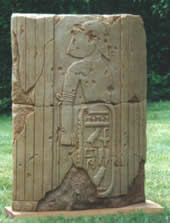Sunday, December 31, 2006
Nations (Language-Egyptian)

“At that time Moses was born, and he was no ordinary child. For three months he was cared for in his father’s house. When he was placed outside, Pharaoh’s daughter took him and brought him up as her own son. Moses was educated in all the wisdom of the Egyptians and was powerful in speech and action.” (Acts 7:20-22 NIV)
The schools of Egypt were for the elite. The court of Egypt provided educational facilities for royal heirs or tributary princes from city-states of the Syro-Palestinian territory subject to the Egyptian rulers. One important aspect of the education would be reading and writing, just as it is with today’s education.
Before proceeding with the details of Egyptian hieroglyphics, various English terminologies need to be defined.
Phonogram: a character or symbol used to represent a word or syllable. For example, a picture of a bee and a leaf to represent the syllables for the word belief are phonograms.
Logogram: a letter, symbol or sign used to represent an entire word. For example, a picture of a heart to mean love in “I love you!” is a logogram.
Ideogram: a picture or symbol used in a system of writing to represent a thing or an idea but not a particular word or phrase. An upside down triangle with red trim implies a driver should yield.
Most hieroglyphic signs are phonetic. These phonograms represent one consonant (uniliteral), two consonants (biliteral), or three consonants (triliteral). The uniliteral signs may be referred to the Egyptian alphabet (see http://en.wikipedia.org/wiki/Egyptian_uniliteral_signs). The biliteral and triliteral signs can be seen at the following locations, respectively:
http://en.wikipedia.org/wiki/Egyptian_biliteral_signs
http://en.wikipedia.org/wiki/Egyptian_triliteral_signs
Hieroglyphics can be read left-to-right, right-to-left, or top-to-bottom. The reader determines the direction of reading by examining the direction the signs are facing. The Egyptians were very concerned with aesthetics; therefore, the hieroglyphics were usually written to give the best visual appearance.
 Like English, ancient Egyptians had homonyms (words like wait and weight). To distinguish the different meanings, many times a scribe would add extra hieroglyphic signs called determinative symbols. These ideograms never carried phonetic importance. A good example can be seen in the picture to the right. The only phonetic signs are the h, n, and u. Because ancient Egyptians did not always insert every vowel (like ancient Hebrew) this word could either be pronounced henu, hinew, ohanow, or some other variant.
Like English, ancient Egyptians had homonyms (words like wait and weight). To distinguish the different meanings, many times a scribe would add extra hieroglyphic signs called determinative symbols. These ideograms never carried phonetic importance. A good example can be seen in the picture to the right. The only phonetic signs are the h, n, and u. Because ancient Egyptians did not always insert every vowel (like ancient Hebrew) this word could either be pronounced henu, hinew, ohanow, or some other variant.One of the most interesting hieroglyphics is found in the Temple at Soleb. On one of the men is written ta sasuw yehua[w] (see the picture of a replica below and see if you can duplicate the translation). The passage is translated “the land of the Shasu, (those of) Yhw.” Shasu refers to people living in Syria and Palestine. Makes one wonder what Yhw stands for (maybe YHWH)!

Other complexities of hieroglyphics are listed below:
1. Sometimes uniliteral symbols follow a triliteral symbol to emphasis the pronunciation.
2. Signs joined together, like an arm holding a scepter, are contractions.
3. Doubling a sign means the word is dual; tripling a sign means the word is plural.
4. The “correct” spelling of a word may not have existed. Sometimes the word would have redundancies, omissions, or alternate spellings.
5. Proper names of kings and queens were encircled with a cartouche.
Pretty complex for an ancient civilization.
REF: Casson, Lionel. Great Ages of Man: Ancient Egypt. Time: New York, 1965.
NIV Archaeological Study Bible. Zondervan: Michigan: 2005.
http://en.wikipedia.org/wiki/Egyptian_hieroglyphs
http://hieroglyphs.net/000501/html/000-002.html